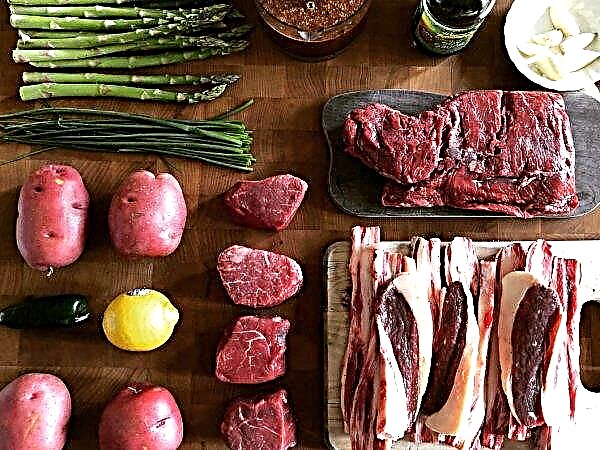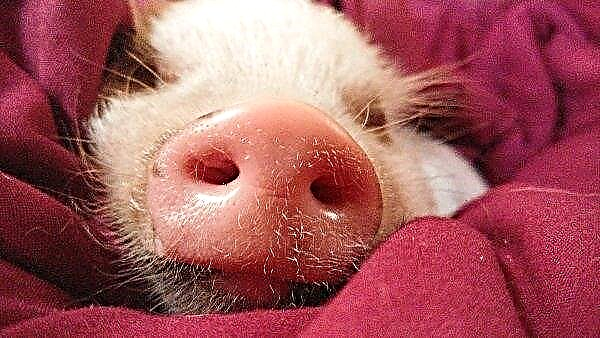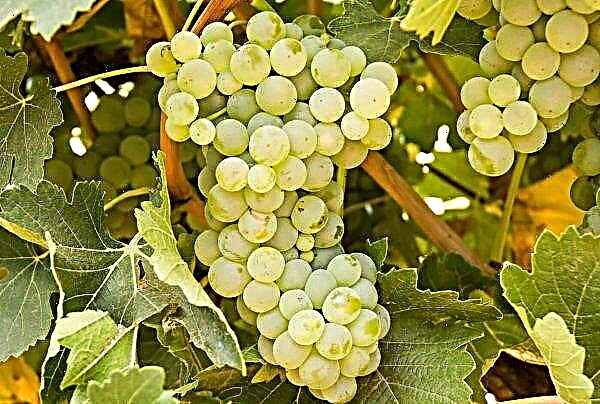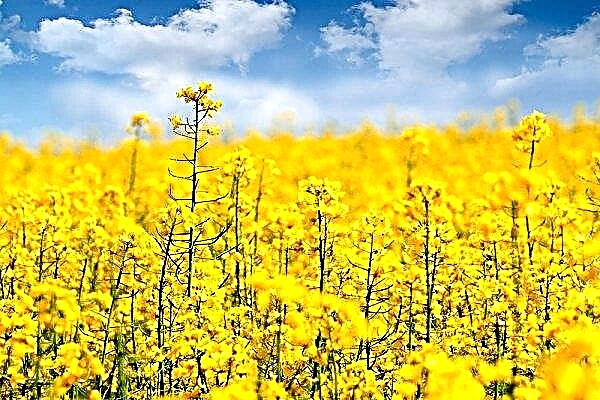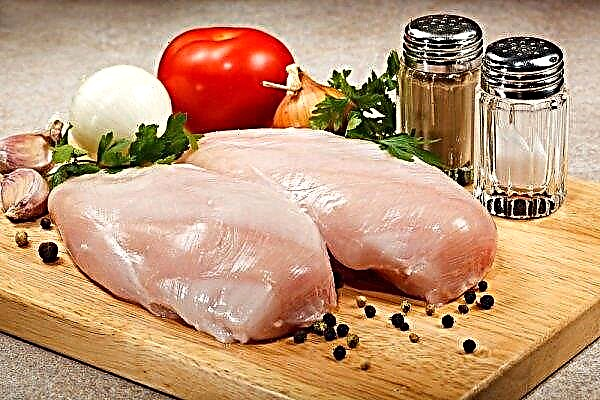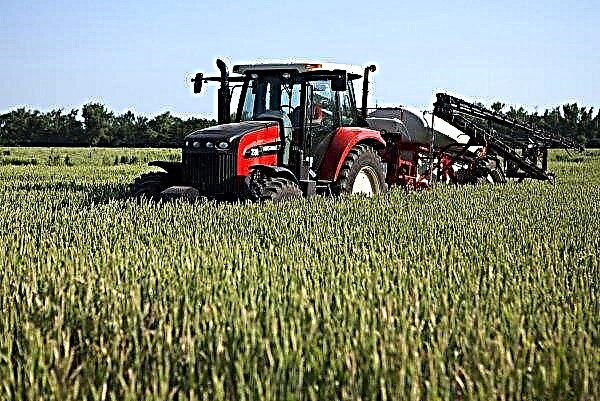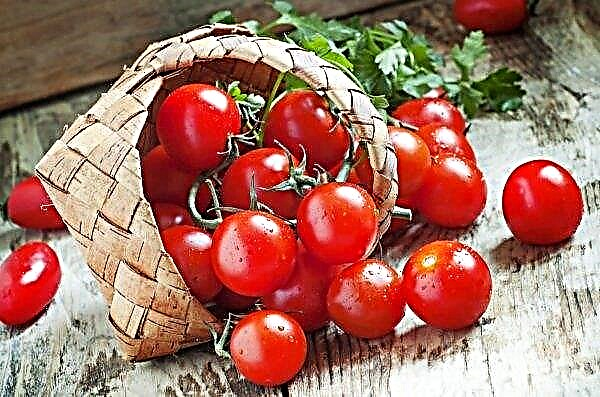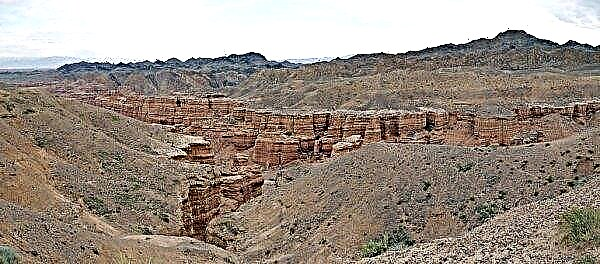Hydrangeas are an excellent solution for decorating both adjoining spacious territories and terraces or balconies inside buildings, the main thing is to choose the most suitable variety for planting and get acquainted with the basic rules for its cultivation. In this article, we will talk about the varietal panicled form of Little Spoky (Little Spooky), which, according to many gardeners, is a universal culture for planting in almost any territory of Russia. Is this really so and what exactly is worth knowing about the features of this hydrangea - read on.
Description of varieties of hydrangeas Little Spocky
Flowers of this kind of Little are represented by dwarf plants growing up to a maximum of 50 cm in height, with a crown width of up to 30 cm. During flowering (lasts from July to August), domed inflorescences with white-greenish lush flowers appear on a compact bush. The leaf plates are oval, pointed at the end and with well-marked longitudinal veins on the surface.
Brown shoots are always densely leafy, so in the summer the bush seems knocked down and very lush. Due to the compact size and high decorativeness of plants, they can be grown both in gardens and in pots, placed in a sunny or semi-shady place of the house. The frost resistance of the culture reaches -25 ° C, so in the south of Russia and in many regions of the central part of the country you can not transplant and cover the bushes during the winter cold.
Did you know? The name of the flowers "hydrangea" is of Greek origin and was originally formed as a result of the merger of the words "hudor" and "angos", which means "a vessel with water". It is likely that the plant received such a “name” because of its moisture loving nature.
How to plant
Planting hydrangeas of Little Spocky variety (Little Spooky) in open ground is based on standard measures that are relevant for the cultivation of other varietal species of this flowering crop.
Having decided on the timing of planting, the gardener is required to select and properly prepare a place suitable for the bush. Once the preparatory phase is completed, it remains only to familiarize yourself with the algorithm for performing the landing itself and you can proceed to the immediate actions.
Video: Planting panicle hydrangea
Departure Dates
Planted panicle hydrangea seedlings can be planted no earlier than the last frost recedes, and the soil warms up to + 8 ... + 10 ° C. Container plants can continue to be moved to the open ground throughout the summer period, but in the middle regions, it is better not to do this before winter.
Important! Despite the relatively high winter hardiness of the described variety, immature seedlings are unlikely to survive the winter, even with frosts of -15 ... -20 ° C.
Site selection
Hydrangea is a photophilous plant, but it will not be able to constantly be under the scorching sun. This is fraught with the late onset of flowering, its limited splendor and general poor development of the shrub in comparison with the options planted in the light partial shade. A good location of the shrub on the site can be considered a place if the flower is lit by the sun mainly in the morning and in the evening, and at lunchtime only scattered rays can fall on it.
As for the composition of the soil on the selected planting area, the representatives of the Little Spocky variety quickly adapt in loamy soil with a high level of acidity. Stagnation of moisture in the root system is unacceptable, therefore, in wetlands you will have to organize good drainage, laying a layer of expanded clay or moss at the bottom of the landing hole.
Dense clay substrates should be mixed with sand, peat and soil taken from under coniferous plants, which will make the soil more suitable for culture.
Soil preparation
For spring planting, they begin to prepare the plot for hydrangeas in the fall, removing all plant debris from the plot, digging the soil in the selected place and, if necessary, fertilizing it with mineral or organic fertilizers (the easiest option to increase the nutritional value of depleted soils is to fill them with humus or compost).
Important! Humus should not be added to the hole, especially if there is a possibility of its contact with the open root system of hydrangea seedlings. In this case, the plant may well get a severe burn and die quickly.
The planting hole itself begins to be prepared a few days before the planting itself, digging a recess in the selected area, at least 45-50 cm. One day before placing the plant, 2-3 buckets of water are poured into the pit, and on the day of planting, the soil pillow consisting of from a mixture of the following components:
- two parts of fertile soil (can be taken from the landing site);
- two parts of peat;
- one part of humus and the same amount of sand;
- 25 g of urea;
- 65 g of superphosphate;
- 25 g of potassium sulfate;
- a small part of the fallen needles.

Landing algorithm
Having prepared a suitable place for the flowers (when planting several plants at once, the distance between neighbors should be at least 1 m), you need to once again examine the selected seedling, if necessary, shorten its roots and if they have dried, then soak for several hours in water, previously adding to it is a root stimulant (for example, "Kornevin").
In the future, the sequence of actions should comply with such a plan:
- Having poured the prepared soil mixture to the middle of the planting hole, place a young plant in the center of the pit and evenly spread its roots on the sides.
- Fill the rhizome with the remaining soil, periodically gently brushing off the seedling to better distribute the substrate between the individual roots (i.e., there should be no voids). At the end of the procedure, the root neck of the flower should be at ground level, without delving into it.
- Seal the surface of the earth and water the planted plant.
- As soon as the liquid is absorbed, mulch the near-trunk zone with a 5-cm layer of peat or humus.
 When planting hydrangea in the spring after planting a seedling in the soil, annual shoots should be trimmed, leaving 3-4 buds.
When planting hydrangea in the spring after planting a seedling in the soil, annual shoots should be trimmed, leaving 3-4 buds.Subsequent Hydrangea Care
In terms of care, the panicled variety of hydrangeas Little Spocky is not much different from other flowering crops in your garden and also requires regular watering, top dressing, periodic pruning and maintenance of the soil to improve its air and moisture permeability. Of course, such standard procedures will have their own characteristics, therefore, before performing work, it is advisable to more carefully study all aspects of caring for the described plant.
Watering and fertilizer
Panicled hydrangea belongs to a moisture-loving group of plants, so prolonged drought can destroy Little Spocky. The optimal regularity of moistening flowering bushes at the initial stages of their development in a new place will be two or three times watering for seven days, with a flow rate of irrigation fluid of at least 3 buckets per hydrangea.
At the same time, one cannot ignore natural precipitation, so if the summer turned out to be rainy, then it is likely that no additional actions will be required from the grower.
Important! Hydrangea water must be settled and free of chlorine impurities. During irrigation, moisture is not allowed on the leaves or, moreover, the flowers of the crop, as this harms their decorative effect.
As for Little Spocka hydrangea fertilizer, in the first year after planting, it is not necessary to add nutrients to the soil, and in the future you can adhere to the following scheme:
- After the first shoots appear on a planted plant, it is worth feeding the bush with complex mineral fertilizers for flowering crops, adhering to the dosage recommended by the manufacturer.
- The second time top dressing is performed after hydrangea buds are formed, that is, in the middle of June. In this case, potassium sulphide and superphosphate mixed in a 7: 4 ratio would be appropriate as a nutrient. To prepare the finished solution, 100 g of this mixture is dissolved in a bucket of water, and then the bushes with flowers are watered.
- Toward the end of summer, a third top dressing is allowed, this time with the use of mullein infusion: one part of the organics is pre-poured with three parts of water and left to infuse for a week. After that, to get the finished dressing, you must additionally dilute the concentrate in clean water in a ratio of 1:10.
 If hydrangea grows well without fertilizer and is characterized by lush flowering, it is likely that feeding will be superfluous. With frequent procedures, branches can break under the weight of the buds.
If hydrangea grows well without fertilizer and is characterized by lush flowering, it is likely that feeding will be superfluous. With frequent procedures, branches can break under the weight of the buds.
Pruning
Trimming panicled hydrangea is a mandatory procedure for caring for the plant, as it allows you to maintain a high decorative bush and maintain its flowering. The optimal time to complete the task in this case will be the end of winter (before laying flower buds), early spring or late autumn, when the buds of the bushes are already closed.
Flowers appear on both young and old shoots, but in the latter case they will not be so lush and beautiful, therefore two or three year old branches can be cut without fear for the general decorativeness of the plant.
Along with old shoots, weak young ones are also subject to removal, characterized by minimal flowering or its complete absence. Forming pruning can be combined with sanitary and carried out in the early spring, and in the autumn to remove only damaged and improperly growing branches, along with faded inflorescences.
In those regions where the bushes do not shelter for the winter (in this case, in the southern regions with winter air drops of -25 ° C), spring pruning is performed without affecting the skeletal branches: if several branches leave from one point at once, then you need to leave the inner by trimming only outward instances. When growing hydrangeas in pots, it is advisable to plan pruning in late autumn, which is quite safe for the bush and will provide lush flowering next year.
Wintering
Given the mediocre frost resistance of Little Spocka hydrangea, in the middle and especially northern regions of Russia it will have to be covered for the winter, and plants growing in tubs should be transferred to a warmer place.
In addition, an important moment will be the preparation for the on-site cold season, which begins with the autumn pruning of faded inflorescences and bundling of branches in several bundles (relevant for wide and well-grown bushes). A few weeks before the expected frosts, the shoots should be covered with burlap, which can protect them not only from frosts, but also from hares, which often damage the bark.
 1- tilted shoots, 2 -cocking, 3- spruce branches, 4- lutrasil, 5- stone
1- tilted shoots, 2 -cocking, 3- spruce branches, 4- lutrasil, 5- stone
Protection against diseases and pests
The main ailments and pests of panicled hydrangea (in particular, the Little Spocky variety) include rot of any kind, chlorosis, powdery mildew, invasion of spider mites, aphids, snails, gall nematodes. All of them, one way or another, change the appearance of the plant, leaving dark spots, damaged holes or sticky mucus on the leaves, shoots or even flowers.
Important! Often, a pest can be detected by visual inspection of the plant, but in order to completely get rid of hydrangea from it, just removing the damaged parts will not be enough.
The most effective ways to solve any of these problems will be the processing of flowers with special chemicals: fungicides or insecticides. A good example of the compositions of the first group will be Alirin-B, Fitosporin-M, Topaz and Skor, and as for special pest killers, most gardeners use Akarin, Komendor, Tanrek, copper sulfate and bordeaux liquid.
A good example of the compositions of the first group will be Alirin-B, Fitosporin-M, Topaz and Skor, and as for special pest killers, most gardeners use Akarin, Komendor, Tanrek, copper sulfate and bordeaux liquid.
The preparation rates and proportions for creating a working mixture are always indicated on the package with the substance, and in order to increase the chances of a successful solution to the problem that has arisen, it is advisable to carry out the processing several times a season, observing an interval of 2-3 weeks between the procedures. Cut damaged branches before spraying, it is recommended to burn immediately, preventing the spread of infection in the area.
For preventive purposes, when growing hydrangea, it is advisable to follow the following recommendations:
- treat seedlings before planting with copper sulfate;
- use drugs against gall nematodes (apply to the soil along with fertilizers);
- to perform preventive treatments several times a season with Bordeaux mixture, copper chloride, copper sulfate or other specialized fungicidal preparations;
- promptly remove weeds and fallen leaves from the beds.
Did you know? In Buddhist culture, hydrangea flower tea is considered a magical drink and is used in various religious rites. For example, on the feast of the birth of Buddha, it is poured on the head of the statue of a saint, believing that the drink has magical properties and will bring good luck.
Breeding methods
Subject to certain requirements for the propagation of Little Spocky hydrangeas, the procedure can be performed both by seed and one of the vegetative methods, having previously prepared the cuttings or highlighting the appropriate cuttings. Which option is better to choose and what you should know about the features of the procedure in a particular case, it is worth knowing before you begin any immediate action.
Cuttings
Obtaining new plants from the mother bush by means of cuttings can be carried out both using green cuttings (cuttings) and using small parts of last year's lignified shoots. In the first case, the harvesting of planting stock is carried out in the summer, when buds have already formed on the hydrangea shoots.
Important! For cutting, green branches of young bushes, with at least one bud and leaves, are suitable.
Usually these are instances from the bottom of the hydrangea, which are better not to cut off, but to pinch off at the base. Subsequently, the obtained sample is further divided into several segments equal to 15 cm each, the lower leaves (together with the petioles) are separated from the cuttings, and only half of the leaf plate is removed from the upper ones. The bottom cut of the shank should be immersed in the stimulator for root formation for two hours (you can use the composition "Epin" or "Kornevin"), and then drop them in boxes with a previously prepared wet substrate.

The best option would be a mixture of two parts of sand and three parts of peat. The deepening of the segments into the soil should be carried out at a slight angle, with the bottom of the cuttings being embedded 5 cm deep. After planting, it is advisable to fill the soil surface with a 2-cm layer of sand, and cover the cuttings themselves with an inverted jar or plastic bag. In warm time, seedlings are irrigated once every three days, and in heat - daily.
The process of growing new hydrangeas from lignified shoots is much like the previous procedure, with the exception of some nuances:
- Harvesting of planting material should be carried out in early spring before the active process of sap flow begins in the plant tissues. The best option would be last year's lignified branches, possibly obtained during the planned spring pruning of the plant.
- The pieces cut at an angle are placed in a container filled with water for 3-5 days, and then cut into several smaller parts, with kidneys on them (at least 3-5 pieces).
- Before planting in the prepared soil, they also need to be treated with a growth stimulator, soaking in the liquid for at least 12 hours.
- For rooting lignified cuttings of panicled hydrangea, you can use, mixed together in a ratio, one part of sand and two - peat.
- Deepening of planting material into the substrate is carried out at 2/3 of its length while maintaining at least 5 cm of free space between adjacent plants.
As in the previous case, the box with seedlings is covered with a jar or plastic film and placed in a warm place for further care. With regular wetting of the substrate, after about a month, the cuttings will take root, and after 2 months they can be planted in open, well-heated soil.
Layering
Reproduction of panicle hydrangea by layering is performed relatively less frequently by cuttings, but this method is also relevant for many gardeners. It is advisable to start work in early spring before buds are blooming on the bushes, for a start loosening the substrate around the main bush. Then, next to its lower lateral layers, it is necessary to organize long trenches with a depth of at least two centimeters.

It is in them that the lateral branches of hydrangea are laid and sealed with soil, and so that the branches do not spring and try to return to their original position, they can be sewn with metal brackets or pieces of wire, wrapping around the base of each shoot. Toward the end of summer, young shoots will appear on the branches, and as soon as they reach a height of 20–25 cm, their hilling can begin.
Important! To get a seedling ready for transplanting, layering should be watered regularly, keeping the soil moist.
Around the middle of autumn, as soon as the branches grow to a half-meter height, they are dug up and separated from each other, after which they are dug up in a place protected from wind and frost until spring. With another warming, it remains only to transplant the finished seedling to a constant place of growth and grow it like a full-fledged hydrangea bush, regularly watering and fertilizing the soil.
Seeds
If you can get quality seeds of Little Spocky variety, then hydrangea can also be propagated by seed. Technically, it is much simpler than the previous options, because all that is required from the grower is to sow planting material in prepared, slightly moist soil. The boxes with seedlings are covered with a film and left for a month under it, regularly spraying the soil from the spray gun and airing the plantings.
Important! For varietal varieties of hydrangeas, seed propagation is not the best solution, because it is never known whether the new plants will retain all varietal characters or not at all resemble the parent form. For this reason, it is mainly the breeders themselves who decide to increase the number of stands in this way.
About a month later, young sprouts will sprout from the seeds, which are transplanted into separate containers and grown for two years. Such hydrangeas are best planted at a permanent place of growth only after three years, when the sprouts will reach 40-50 cm in height.
Little Spocky panicle hydrangea is a really good solution for growing in the garden or indoors. Providing her with all the conditions for proper growth and development, the bushes will always delight you with magnificent forms and abundant flowering, becoming a good decoration for the home and household territory.

